A New SQP Methodology for Coordinated Transformer Tap Control Optimization in Electric Networks Integrating Wind Farms
Abstract
:1. Introduction
- reducing greenhouse gas emissions by at least 40% compared to 1990;
- the consumption of renewable energy to be 32%;
- improving energy efficiency by 32.5%;
- interconnecting the electricity market at a level of 15%.
1.1. Related Literature
1.2. Main Contributions
- Developing a data structure integrated into a real-time query procedure that uploads information from the SCADA master system and saves them in two databases (Topology Database and Profiles Database) accessed by the OPF module. This structure enables high-speed data processing.
- Treating the OPF problem as a successive quadratic programming (SQP) problem and accelerating convergence using the conjugate reduced gradient method. The small number of iterations and the fast computational time represent the strong points and recommend it for real-time work.
- Performing deep research, considering a real network, representing a zone of the Romanian transmission and distribution system, where two scenarios have been analyzed (without and with wind farms connected) to quantify the benefits on the operation of the network with the wind power sources integrated overlapping the coordinated control of the OLTCs. The considered scenarios (together with the three cases analyzed within the second scenario) cover all situations associated with the steady-state of the electrical networks.
1.3. Paper Organization
2. Materials and Methods
2.1. Stage 1. Input Data Management
2.1.1. Topology Database
- Bus i, Bus j—represent the two terminals (i—input and j—output) of an element (line or power transformer) associated with the main components (electric substations, the classical power plants, and the wind farms) identified through the numbers in the topology;
- Element—is associated with the power transformer (T) or the line (L) between Bus i and Bus j;
- Voltage—indicated the voltage level, in (kV), for the operation of the Element between Bus i and Bus j;
- Type—is the identification number of the element in the Lines Database or Transformers Database containing the technical specific parameters: rated voltage, resistance, reactance, conductance, susceptance, and the number of tap positions (in the case of the transformers);
- Length—is the length, in (km), when the Element between Bus i and Bus j represents a line. If the Element is a power transformer, then Length = 0;
- Tap—is the operating tap position if the Element between Bus i and Bus j represents a power transformer. If the Element is a line, then Tap = 0;
- Circuits—represent the number of the circuits (in the case of the lines) or units (in the case of the power transformers) between Bus i and Bus j.
2.1.2. Load/Generation Profiles Database
- Bus—the identification number of the bus from the topology of the electric network;
- Bus Type—allows the identification of the buses depending on the classification in PQ, PV, and slack-bus (S). The PQ (or load) bus has known the real active (P) and reactive power (Q). The PV (or generator) bus supposes the known real power P and the voltage magnitude V. The slack (or reference) bus (S) ensures the balance of the powers (active and reactive) in the system.
- P1, Q1, P2, Q2, … are the transmitted or injected active and reactive powers recorded at hour h = 1, 2, …, TH, usually TH = 24, depending on the bus type (load or generator).
2.2. Stage 2. Successive Quadratic Programming-Based OPF
2.2.1. OPF Problem Formulation
- Active and reactive power balances
- Voltage magnitude
- Active and reactive power generation at the conventional generator buses
- Active power generation at buses associated with a wind farm
- Transformer tap
- Line loadingwhere:
- E—the total number of the elements (lines and transformers) in the networks;
- s—slack bus;
- Ng—the set of conventional generator buses in the network;
- Ge—the real part of element e between the i-th bus and j-th bus from the nodal admittance matrix;
- Vi,h—the voltage magnitude at the i-th bus and hour h;
- Vj,h—the voltage magnitude at the j-th bus and hour h;
- Gij—the real part of element ij from the nodal admittance matrix;
- Bij—the imaginary part of element ij from the nodal admittance matrix;
- PGi,h, QGi,h—the active and reactive powers generated at the i-th bus and hour h;
- PLi,h, QLi,h—the active and reactive powers required at the i-th bus and hour h;
- tij,h—the tap position of the transformer connected between the i-th bus and j-th bus and hour h;
- Sij max—the maximum load of the line connected between the i-th bus and j-th bus;
- PGlmin, PGlmax—the active power limits of the l-th conventional power plant;
- QGlmin, QGlmax—the reactive power limits of the l-th conventional power plant;
- Pwmin, Pwmax—the active power limits of the w-th wind farm;
- Pw—the active power of the w-th wind farm.
2.2.2. The Successive Quadratic Programming-Based Optimization Algorithm
- if αj(k) ≤ 0, then the inactive constraint j, j = 1, …, q, is exceeded at the starting point and is transformed into an active constraint. Further, the number of the independent variable will decrease with 1;
- if < , then α(k) = ;
- if > then α(k) = .
3. Case Study
- Case 1: Wind Farm 1 (connected at the bus 6) is ON, and Wind Farm 2 (connected at the bus 8) is OFF;
- Case 2: Wind Farm 1 (connected at the bus 6) is OFF, and Wind Farm 2 (connected at the bus 8) is ON;
- Case 3: Both wind farms are ON.
4. Conclusions
Supplementary Materials
Author Contributions
Funding
Institutional Review Board Statement
Informed Consent Statement
Conflicts of Interest
Nomenclature and Indices
| OPF | Optimal power flow |
| DNO | Distribution Network Operator |
| TSO | Transmission System Operator |
| SQP | Successive quadratic programming |
| RG | Reduced Gradient |
| CC | Centralized control |
| SCADA | Supervisory Control and Data Acquisition |
| EU | European Union |
| NECP | National Energy and Climate Plan |
| DM | Decision-Maker |
| OLTC | On-load tap changers |
| RTU | Remote terminal unit |
| CDC | Central data concentrator |
| AVC | Automatic voltage control |
| IEEE | Institute of Electrical and Electronics Engineers |
| DC | Direct Current |
| VA | structure vector recording records areas of the electric network |
| VE | structure vector containing elements (electric line/power transformer from each area recorded in the vector VA |
| SB | slack bus |
| Nw | the set of wind generator buses in the network |
| N | the set of all buses in the network |
| E | the total number of the elements (lines and transformers) in the networks |
| s | index for the slack bus |
| Ng | the set of conventional generator buses in the network |
| Ge | the real part of element e between the i-th bus and j-th bus from the nodal admittance matrix |
| TH | the analyzed time period |
| Vi,h | the voltage magnitude at the i-th bus and hour h, in (kV) |
| Vj,h | the voltage magnitude at the j-th bus and hour h, in (kV) |
| Gij | the real part of element ij from nodal admittance matrix |
| Bij | the imaginary part of element ij from nodal admittance matrix |
| PGi,h, QGi,h | the active and reactive powers generated at the i-th bus and hour h, in (MW) and (MVAr) |
| PLi,h, QLi,h | the active and reactive powers required at the i-th bus and hour h, in (MW) and (MVAr) |
| tij,h | the tap position of the transformer connected between the i-th bus and j-th bus and hour h |
| Sij max | the maximum load of the line connected between the i-th bus and j-th bus, in (MVA) |
| PGlmin, PGlmax | the active power limits of the l-th conventional power plant, in (MW) |
| QGlmin, QGlmax | the reactive power limits of the l-th conventional power plant, in (MVAr) |
| Pwmin, Pwmax | the active power limits of the w-th wind farm, in (MW) |
| Pw | the active power of the w-th wind farm, in (MW) |
| [X] | the optimization vector |
| F([X]) | objective function |
| hAi([X]) | the equality restriction i, i = 1, …, p |
| p | the number of the active equality restrictions |
| hIj([X]) | the inactive inequality restriction j, j = 1, …, q |
| q | the number of the equality restrictions |
| [X(0)] | a feasible starting point of the optimization process |
| Z([ΔX]) | the objective function of the QP problem |
| [ΔX] | the vector of the optimization variables associated with the QP problem |
| [H] | the Hessian of the objective function |
| F(0) | the value of the objective function F calculated at the starting point [X(0)] |
| the gradient of the objective function calculated at the starting point [X(0)] | |
| [hA(0)] | the vector of the active constraints at the starting point [X(0)] |
| [hI(0)] | the vector of the inactive constraints at the starting point [X(0)] |
| [JA] | the Jacobian of the active constraints |
| [JI] | the Jacobian of the inactive constraints |
| [∆Z] | the control (independent) variables |
| [∆Y] | the state (dependent) variables |
| αopt(k) | the optimal value of step size |
| αadm(k) | the admissible value of the step size |
| ΔFLoss,h(MW) | the power saving calculated in MW at hour h |
| ΔFLoss,h (%) | the power saving calculated in percent at hour h |
| F*Loss,h | the power losses calculated without a coordinated control of the OLTCs at the hour h, in (MW) |
| F**Loss,h | the power losses calculated with coordinated control of the OLTCs at the hour h, in (MW) |
| ES(MWh) | the energy-saving calculated in MWh |
| ES(%) | the energy-saving calculated in percent |
| Q0–Q4 | the quartiles |
| CTav | the average computational time |
| cth,c | the computing time in which the solution of the OPF problem was obtained for hour h, h = 1, …, TH, and the case c, c = 1, …, Ncases. |
| Ncases | the number of analyzed cases |
Appendix A
| Hour | without Coordinated Control of the OLTCs | with Coordinated Control of the OLTCs | ||||||||||||
|---|---|---|---|---|---|---|---|---|---|---|---|---|---|---|
| Bus2 | Bus3 | Bus4 | Bus6 | Bus7 | Bus8 | Bus10 | Bus2 | Bus3 | Bus4 | Bus6 | Bus7 | Bus8 | Bus10 | |
| 1 | 1.100 | 1.094 | 1.091 | 1.089 | 1.076 | 1.062 | 1.062 | 1.037 | 1.031 | 1.031 | 1.032 | 1.027 | 1.027 | 1.023 |
| 2 | 1.100 | 1.095 | 1.092 | 1.090 | 1.077 | 1.063 | 1.063 | 1.038 | 1.032 | 1.032 | 1.033 | 1.028 | 1.028 | 1.027 |
| 3 | 1.100 | 1.095 | 1.092 | 1.090 | 1.077 | 1.063 | 1.063 | 1.038 | 1.032 | 1.032 | 1.033 | 1.028 | 1.028 | 1.027 |
| 4 | 1.100 | 1.095 | 1.092 | 1.090 | 1.077 | 1.063 | 1.063 | 1.038 | 1.032 | 1.032 | 1.033 | 1.028 | 1.028 | 1.027 |
| 5 | 1.100 | 1.094 | 1.092 | 1.090 | 1.076 | 1.062 | 1.062 | 1.037 | 1.031 | 1.031 | 1.032 | 1.027 | 1.027 | 1.026 |
| 6 | 1.098 | 1.092 | 1.089 | 1.088 | 1.074 | 1.059 | 1.059 | 1.038 | 1.037 | 1.037 | 1.039 | 1.033 | 1.034 | 1.033 |
| 7 | 1.093 | 1.085 | 1.083 | 1.081 | 1.066 | 1.051 | 1.051 | 1.042 | 1.035 | 1.035 | 1.036 | 1.029 | 1.029 | 1.028 |
| 8 | 1.091 | 1.082 | 1.080 | 1.078 | 1.063 | 1.048 | 1.048 | 1.054 | 1.046 | 1.046 | 1.047 | 1.039 | 1.038 | 1.038 |
| 9 | 1.088 | 1.079 | 1.077 | 1.075 | 1.059 | 1.044 | 1.044 | 1.051 | 1.042 | 1.042 | 1.043 | 1.035 | 1.034 | 1.034 |
| 10 | 1.088 | 1.079 | 1.077 | 1.075 | 1.059 | 1.045 | 1.044 | 1.051 | 1.042 | 1.042 | 1.043 | 1.035 | 1.035 | 1.034 |
| 11 | 1.088 | 1.079 | 1.077 | 1.075 | 1.059 | 1.044 | 1.044 | 1.051 | 1.042 | 1.042 | 1.043 | 1.035 | 1.034 | 1.034 |
| 12 | 1.088 | 1.078 | 1.076 | 1.075 | 1.059 | 1.044 | 1.044 | 1.056 | 1.049 | 1.052 | 1.048 | 1.045 | 1.037 | 1.036 |
| 13 | 1.089 | 1.080 | 1.078 | 1.076 | 1.060 | 1.046 | 1.045 | 1.051 | 1.043 | 1.043 | 1.044 | 1.036 | 1.036 | 1.035 |
| 14 | 1.088 | 1.079 | 1.076 | 1.075 | 1.059 | 1.044 | 1.044 | 1.050 | 1.041 | 1.041 | 1.043 | 1.035 | 1.034 | 1.033 |
| 15 | 1.089 | 1.081 | 1.078 | 1.077 | 1.061 | 1.046 | 1.046 | 1.052 | 1.044 | 1.044 | 1.045 | 1.037 | 1.037 | 1.036 |
| 16 | 1.091 | 1.082 | 1.080 | 1.078 | 1.063 | 1.049 | 1.048 | 1.055 | 1.050 | 1.050 | 1.051 | 1.044 | 1.043 | 1.043 |
| 17 | 1.090 | 1.082 | 1.079 | 1.078 | 1.062 | 1.048 | 1.047 | 1.053 | 1.045 | 1.045 | 1.046 | 1.038 | 1.038 | 1.037 |
| 18 | 1.089 | 1.080 | 1.077 | 1.076 | 1.060 | 1.045 | 1.045 | 1.052 | 1.043 | 1.043 | 1.044 | 1.036 | 1.035 | 1.034 |
| 19 | 1.088 | 1.079 | 1.076 | 1.075 | 1.058 | 1.044 | 1.044 | 1.051 | 1.041 | 1.042 | 1.043 | 1.034 | 1.034 | 1.033 |
| 20 | 1.090 | 1.081 | 1.079 | 1.077 | 1.061 | 1.047 | 1.046 | 1.053 | 1.044 | 1.044 | 1.045 | 1.037 | 1.037 | 1.036 |
| 21 | 1.092 | 1.084 | 1.081 | 1.080 | 1.064 | 1.050 | 1.050 | 1.056 | 1.047 | 1.047 | 1.048 | 1.041 | 1.040 | 1.040 |
| 22 | 1.095 | 1.087 | 1.085 | 1.083 | 1.068 | 1.054 | 1.054 | 1.044 | 1.037 | 1.037 | 1.038 | 1.031 | 1.031 | 1.030 |
| 23 | 1.097 | 1.090 | 1.087 | 1.085 | 1.071 | 1.057 | 1.057 | 1.036 | 1.034 | 1.035 | 1.036 | 1.031 | 1.031 | 1.031 |
| 24 | 1.098 | 1.092 | 1.089 | 1.087 | 1.074 | 1.059 | 1.059 | 1.049 | 1.042 | 1.042 | 1.043 | 1.037 | 1.037 | 1.036 |
| Hour | without Coordinated Control of the OLTCs | with Coordinated Control of the OLTCs | ||||||||||||
|---|---|---|---|---|---|---|---|---|---|---|---|---|---|---|
| Bus2 | Bus3 | Bus4 | Bus6 | Bus7 | Bus8 | Bus10 | Bus2 | Bus3 | Bus4 | Bus6 | Bus7 | Bus8 | Bus10 | |
| 1 | 1.100 | 1.099 | 1.097 | 1.095 | 1.080 | 1.065 | 1.065 | 1.035 | 1.031 | 1.031 | 1.031 | 1.028 | 1.028 | 1.028 |
| 2 | 1.100 | 1.101 | 1.099 | 1.098 | 1.082 | 1.066 | 1.066 | 1.039 | 1.039 | 1.040 | 1.041 | 1.033 | 1.031 | 1.031 |
| 3 | 1.100 | 1.100 | 1.099 | 1.098 | 1.082 | 1.066 | 1.066 | 1.039 | 1.038 | 1.039 | 1.041 | 1.033 | 1.031 | 1.031 |
| 4 | 1.100 | 1.100 | 1.099 | 1.097 | 1.082 | 1.066 | 1.066 | 1.039 | 1.038 | 1.039 | 1.040 | 1.033 | 1.031 | 1.031 |
| 5 | 1.100 | 1.099 | 1.098 | 1.096 | 1.081 | 1.065 | 1.065 | 1.036 | 1.032 | 1.032 | 1.032 | 1.028 | 1.029 | 1.028 |
| 6 | 1.099 | 1.098 | 1.097 | 1.095 | 1.079 | 1.063 | 1.063 | 1.037 | 1.038 | 1.038 | 1.039 | 1.035 | 1.037 | 1.036 |
| 7 | 1.094 | 1.092 | 1.090 | 1.089 | 1.071 | 1.056 | 1.055 | 1.044 | 1.044 | 1.044 | 1.046 | 1.040 | 1.042 | 1.041 |
| 8 | 1.092 | 1.089 | 1.087 | 1.086 | 1.068 | 1.052 | 1.052 | 1.053 | 1.046 | 1.046 | 1.047 | 1.041 | 1.041 | 1.040 |
| 9 | 1.089 | 1.087 | 1.086 | 1.085 | 1.065 | 1.049 | 1.049 | 1.065 | 1.058 | 1.058 | 1.059 | 1.052 | 1.052 | 1.051 |
| 10 | 1.090 | 1.088 | 1.088 | 1.087 | 1.067 | 1.050 | 1.050 | 1.065 | 1.060 | 1.060 | 1.061 | 1.053 | 1.053 | 1.052 |
| 11 | 1.089 | 1.088 | 1.087 | 1.086 | 1.066 | 1.050 | 1.050 | 1.065 | 1.059 | 1.059 | 1.060 | 1.053 | 1.053 | 1.052 |
| 12 | 1.089 | 1.086 | 1.085 | 1.085 | 1.065 | 1.049 | 1.049 | 1.064 | 1.058 | 1.058 | 1.059 | 1.052 | 1.052 | 1.051 |
| 13 | 1.090 | 1.088 | 1.087 | 1.086 | 1.067 | 1.051 | 1.050 | 1.065 | 1.059 | 1.060 | 1.060 | 1.053 | 1.053 | 1.053 |
| 14 | 1.089 | 1.086 | 1.085 | 1.085 | 1.065 | 1.049 | 1.049 | 1.070 | 1.072 | 1.072 | 1.072 | 1.066 | 1.066 | 1.065 |
| 15 | 1.090 | 1.088 | 1.087 | 1.086 | 1.067 | 1.051 | 1.051 | 1.054 | 1.053 | 1.054 | 1.055 | 1.049 | 1.050 | 1.050 |
| 16 | 1.092 | 1.090 | 1.089 | 1.088 | 1.069 | 1.053 | 1.053 | 1.056 | 1.055 | 1.056 | 1.057 | 1.051 | 1.053 | 1.052 |
| 17 | 1.091 | 1.090 | 1.088 | 1.088 | 1.068 | 1.052 | 1.052 | 1.055 | 1.055 | 1.056 | 1.057 | 1.051 | 1.052 | 1.051 |
| 18 | 1.090 | 1.087 | 1.086 | 1.085 | 1.066 | 1.050 | 1.049 | 1.054 | 1.052 | 1.053 | 1.055 | 1.048 | 1.049 | 1.048 |
| 19 | 1.091 | 1.086 | 1.085 | 1.084 | 1.064 | 1.049 | 1.048 | 1.053 | 1.051 | 1.052 | 1.053 | 1.046 | 1.048 | 1.047 |
| 20 | 1.091 | 1.089 | 1.087 | 1.086 | 1.067 | 1.051 | 1.051 | 1.055 | 1.054 | 1.055 | 1.056 | 1.049 | 1.051 | 1.050 |
| 21 | 1.093 | 1.091 | 1.090 | 1.089 | 1.070 | 1.054 | 1.054 | 1.043 | 1.043 | 1.044 | 1.045 | 1.039 | 1.041 | 1.040 |
| 22 | 1.096 | 1.094 | 1.092 | 1.091 | 1.073 | 1.058 | 1.058 | 1.043 | 1.038 | 1.038 | 1.039 | 1.034 | 1.034 | 1.033 |
| 23 | 1.097 | 1.095 | 1.093 | 1.092 | 1.083 | 1.060 | 1.060 | 1.045 | 1.040 | 1.040 | 1.040 | 1.036 | 1.037 | 1.036 |
| 24 | 1.099 | 1.097 | 1.096 | 1.094 | 1.078 | 1.063 | 1.063 | 1.036 | 1.035 | 1.036 | 1.037 | 1.029 | 1.027 | 1.027 |
| Hour | without Coordinated Control of the OLTCs | with Coordinated Control of the OLTCs | ||||||||||||
|---|---|---|---|---|---|---|---|---|---|---|---|---|---|---|
| Bus2 | Bus3 | Bus4 | Bus6 | Bus7 | Bus8 | Bus10 | Bus2 | Bus3 | Bus4 | Bus6 | Bus7 | Bus8 | Bus10 | |
| 1 | 1.100 | 1.095 | 1.093 | 1.091 | 1.080 | 1.067 | 1.067 | 1.051 | 1.046 | 1.046 | 1.046 | 1.044 | 1.045 | 1.044 |
| 2 | 1.100 | 1.097 | 1.094 | 1.092 | 1.082 | 1.069 | 1.069 | 1.052 | 1.048 | 1.048 | 1.048 | 1.046 | 1.047 | 1.047 |
| 3 | 1.100 | 1.097 | 1.094 | 1.092 | 1.081 | 1.069 | 1.069 | 1.052 | 1.047 | 1.047 | 1.048 | 1.045 | 1.047 | 1.046 |
| 4 | 1.100 | 1.097 | 1.094 | 1.092 | 1.081 | 1.069 | 1.069 | 1.052 | 1.047 | 1.047 | 1.048 | 1.045 | 1.047 | 1.045 |
| 5 | 1.100 | 1.096 | 1.093 | 1.091 | 1.080 | 1.068 | 1.068 | 1.051 | 1.047 | 1.047 | 1.047 | 1.044 | 1.046 | 1.045 |
| 6 | 1.099 | 1.094 | 1.092 | 1.090 | 1.078 | 1.066 | 1.066 | 1.049 | 1.045 | 1.044 | 1.045 | 1.042 | 1.044 | 1.043 |
| 7 | 1.093 | 1.087 | 1.085 | 1.083 | 1.071 | 1.059 | 1.059 | 1.042 | 1.035 | 1.036 | 1.037 | 1.029 | 1.028 | 1.027 |
| 8 | 1.092 | 1.085 | 1.082 | 1.081 | 1.067 | 1.055 | 1.055 | 1.040 | 1.034 | 1.034 | 1.035 | 1.030 | 1.032 | 1.031 |
| 9 | 1.089 | 1.082 | 1.079 | 1.078 | 1.065 | 1.053 | 1.053 | 1.051 | 1.045 | 1.045 | 1.046 | 1.041 | 1.043 | 1.042 |
| 10 | 1.089 | 1.083 | 1.080 | 1.079 | 1.066 | 1.055 | 1.055 | 1.066 | 1.060 | 1.060 | 1.060 | 1.056 | 1.059 | 1.058 |
| 11 | 1.089 | 1.082 | 1.080 | 1.078 | 1.066 | 1.054 | 1.054 | 1.051 | 1.045 | 1.045 | 1.046 | 1.042 | 1.044 | 1.044 |
| 12 | 1.088 | 1.081 | 1.079 | 1.077 | 1.065 | 1.053 | 1.053 | 1.050 | 1.044 | 1.044 | 1.045 | 1.041 | 1.043 | 1.042 |
| 13 | 1.089 | 1.083 | 1.080 | 1.079 | 1.066 | 1.055 | 1.054 | 1.052 | 1.046 | 1.046 | 1.047 | 1.043 | 1.045 | 1.044 |
| 14 | 1.088 | 1.081 | 1.079 | 1.078 | 1.065 | 1.053 | 1.053 | 1.036 | 1.030 | 1.030 | 1.032 | 1.027 | 1.030 | 1.029 |
| 15 | 1.090 | 1.083 | 1.081 | 1.079 | 1.067 | 1.055 | 1.054 | 1.053 | 1.046 | 1.046 | 1.047 | 1.043 | 1.045 | 1.044 |
| 16 | 1.091 | 1.085 | 1.085 | 1.081 | 1.069 | 1.057 | 1.057 | 1.039 | 1.032 | 1.033 | 1.034 | 1.026 | 1.026 | 1.025 |
| 17 | 1.091 | 1.085 | 1.082 | 1.080 | 1.068 | 1.056 | 1.056 | 1.069 | 1.062 | 1.062 | 1.062 | 1.058 | 1.060 | 1.059 |
| 18 | 1.089 | 1.082 | 1.080 | 1.078 | 1.065 | 1.053 | 1.053 | 1.067 | 1.060 | 1.059 | 1.060 | 1.055 | 1.057 | 1.056 |
| 19 | 1.089 | 1.081 | 1.079 | 1.077 | 1.064 | 1.052 | 1.052 | 1.066 | 1.058 | 1.058 | 1.059 | 1.054 | 1.056 | 1.055 |
| 20 | 1.090 | 1.084 | 1.081 | 1.080 | 1.067 | 1.055 | 1.055 | 1.068 | 1.061 | 1.061 | 1.062 | 1.057 | 1.059 | 1.058 |
| 21 | 1.093 | 1.087 | 1.084 | 1.082 | 1.070 | 1.058 | 1.058 | 1.041 | 1.034 | 1.035 | 1.036 | 1.028 | 1.027 | 1.026 |
| 22 | 1.095 | 1.089 | 1.087 | 1.085 | 1.073 | 1.061 | 1.061 | 1.045 | 1.039 | 1.039 | 1.040 | 1.036 | 1.039 | 1.038 |
| 23 | 1.097 | 1.092 | 1.089 | 1.087 | 1.075 | 1.063 | 1.063 | 1.033 | 1.029 | 1.029 | 1.029 | 1.026 | 1.028 | 1.027 |
| 24 | 1.098 | 1.094 | 1.091 | 1.089 | 1.078 | 1.065 | 1.065 | 1.049 | 1.044 | 1.044 | 1.044 | 1.041 | 1.043 | 1.042 |
| Hour | without Coordinated Control of the OLTCs | with Coordinated Control of the OLTCs | ||||||||||||
|---|---|---|---|---|---|---|---|---|---|---|---|---|---|---|
| Bus2 | Bus3 | Bus4 | Bus6 | Bus7 | Bus8 | Bus10 | Bus2 | Bus3 | Bus4 | Bus6 | Bus7 | Bus8 | Bus10 | |
| 1 | 1.100 | 1.100 | 1.098 | 1.097 | 1.083 | 1.070 | 1.070 | 1.049 | 1.047 | 1.045 | 1.045 | 1.044 | 1.047 | 1.046 |
| 2 | 1.100 | 1.100 | 1.100 | 1.099 | 1.086 | 1.073 | 1.073 | 1.039 | 1.045 | 1.041 | 1.043 | 1.037 | 1.038 | 1.037 |
| 3 | 1.100 | 1.100 | 1.100 | 1.099 | 1.086 | 1.072 | 1.072 | 1.051 | 1.040 | 1.048 | 1.048 | 1.047 | 1.049 | 1.049 |
| 4 | 1.100 | 1.100 | 1.100 | 1.099 | 1.086 | 1.072 | 1.072 | 1.051 | 1.048 | 1.047 | 1.048 | 1.047 | 1.049 | 1.049 |
| 5 | 1.100 | 1.100 | 1.099 | 1.098 | 1.084 | 1.071 | 1.071 | 1.050 | 1.048 | 1.046 | 1.046 | 1.045 | 1.048 | 1.047 |
| 6 | 1.099 | 1.100 | 1.099 | 1.097 | 1.083 | 1.070 | 1.070 | 1.048 | 1.046 | 1.045 | 1.046 | 1.044 | 1.047 | 1.046 |
| 7 | 1.094 | 1.094 | 1.093 | 1.092 | 1.076 | 1.063 | 1.063 | 1.056 | 1.045 | 1.052 | 1.052 | 1.050 | 1.052 | 1.052 |
| 8 | 1.092 | 1.091 | 1.089 | 1.088 | 1.072 | 1.059 | 1.058 | 1.054 | 1.052 | 1.048 | 1.049 | 1.045 | 1.048 | 1.047 |
| 9 | 1.090 | 1.090 | 1.088 | 1.088 | 1.071 | 1.058 | 1.058 | 1.067 | 1.048 | 1.068 | 1.070 | 1.061 | 1.062 | 1.061 |
| 10 | 1.090 | 1.091 | 1.091 | 1.090 | 1.073 | 1.060 | 1.060 | 1.068 | 1.067 | 1.070 | 1.072 | 1.064 | 1.064 | 1.063 |
| 11 | 1.090 | 1.091 | 1.090 | 1.089 | 1.073 | 1.060 | 1.059 | 1.067 | 1.069 | 1.069 | 1.071 | 1.063 | 1.063 | 1.062 |
| 12 | 1.089 | 1.089 | 1.088 | 1.087 | 1.071 | 1.058 | 1.057 | 1.066 | 1.068 | 1.068 | 1.069 | 1.061 | 1.061 | 1.061 |
| 13 | 1.090 | 1.091 | 1.090 | 1.089 | 1.073 | 1.059 | 1.059 | 1.068 | 1.066 | 1.069 | 1.071 | 1.063 | 1.063 | 1.062 |
| 14 | 1.089 | 1.089 | 1.088 | 1.087 | 1.071 | 1.057 | 1.057 | 1.066 | 1.068 | 1.067 | 1.069 | 1.061 | 1.061 | 1.060 |
| 15 | 1.091 | 1.090 | 1.089 | 1.088 | 1.072 | 1.059 | 1.059 | 1.066 | 1.066 | 1.062 | 1.062 | 1.059 | 1.062 | 1.061 |
| 16 | 1.092 | 1.092 | 1.091 | 1.090 | 1.075 | 1.062 | 1.061 | 1.068 | 1.062 | 1.064 | 1.064 | 1.061 | 1.064 | 1.064 |
| 17 | 1.092 | 1.092 | 1.091 | 1.090 | 1.074 | 1.061 | 1.061 | 1.070 | 1.064 | 1.071 | 1.073 | 1.065 | 1.065 | 1.064 |
| 18 | 1.090 | 1.090 | 1.088 | 1.088 | 1.071 | 1.058 | 1.058 | 1.066 | 1.070 | 1.061 | 1.062 | 1.058 | 1.061 | 1.060 |
| 19 | 1.090 | 1.089 | 1.087 | 1.087 | 1.070 | 1.057 | 1.056 | 1.067 | 1.061 | 1.067 | 1.069 | 1.060 | 1.060 | 1.060 |
| 20 | 1.091 | 1.091 | 1.090 | 1.089 | 1.073 | 1.059 | 1.059 | 1.067 | 1.066 | 1.062 | 1.063 | 1.059 | 1.062 | 1.061 |
| 21 | 1.094 | 1.094 | 1.092 | 1.091 | 1.075 | 1.062 | 1.062 | 1.055 | 1.062 | 1.051 | 1.052 | 1.049 | 1.052 | 1.051 |
| 22 | 1.096 | 1.096 | 1.094 | 1.093 | 1.078 | 1.065 | 1.065 | 1.046 | 1.051 | 1.047 | 1.049 | 1.042 | 1.043 | 1.042 |
| 23 | 1.098 | 1.097 | 1.095 | 1.094 | 1.079 | 1.066 | 1.066 | 1.046 | 1.046 | 1.042 | 1.042 | 1.040 | 1.043 | 1.042 |
| 24 | 1.099 | 1.099 | 1.097 | 1.096 | 1.082 | 1.068 | 1.068 | 1.047 | 1.042 | 1.044 | 1.044 | 1.043 | 1.045 | 1.045 |
References
- European Commission. Paris Agreement. Available online: https://ec.europa.eu/clima/eu-action/international-action-climate-change/climate-negotiations/paris-agreement_en (accessed on 2 December 2021).
- European Commission. Energy Union. Available online: https://ec.europa.eu/energy/topics/energy-strategy/energy-union_en (accessed on 2 December 2021).
- WindEurope. National Energy & Climate Plans. Available online: https://windeurope.org/2030plans/ (accessed on 2 December 2021).
- SandBag. Capitalizing on the Renewable Potential of Romania. The Road to Carbon Neutrality. Available online: https://sandbag.be/wp-content/uploads/2020/10/Valorificarea-Potentialului-Regenerabil-al-Romaniei-RO.pdf (accessed on 2 December 2021). (In Romanian).
- European Commission. The 2021–2030 Integrated National Energy and Climate Plan. Available online: https://ec.europa.eu/energy/sites/default/files/documents/ro_final_necp_main_en.pdf (accessed on 2 December 2021).
- Energy Policy Group. Study: Accelerated Lignite Exit in Bulgaria, Romania and Greece. Available online: https://www.enpg.ro/study-accelerated-lignite-exit-in-bulgaria-romania-and-greece-eng-ro/ (accessed on 2 December 2021).
- Ministry of Energy of Romania. Environmental Report for the Romanian Energy Strategy 2019–2030, with the Perspective for 2050. Available online: https://2015-2019.kormany.hu/download/5/06/b1000/03_RO%20Energiastrat%20Korny%20ertekeles%20EN.pdf (accessed on 2 December 2021).
- Ernst & Young. Renewable Energies Can Accelerate the Decarbonisation of the Romanian Energy Sector, but Public Initiatives Must Be in Sync with Business Intentions. Available online: https://www.ey.com/ro_ro/news/2021/04/ey-romania-report--renewables-can-accelerate-the-decarbonisation (accessed on 2 December 2021).
- Holttinen, H.; Meibom, P.; Orths, A.; Hulle, F.V.; Ensslin, C.; Hofmann, L.; McCann, J.; Pierik, J.; Tande, J.O.; Estanqueiro, A.; et al. Design and Operation of Power Systems with Large Amounts of Wind Power, First Results of IEA Collaboration. In Proceedings of the 6th International Workshop on Large-Scale Integration of Wind Power and Transmission Networks for Offshore Wind Farms, Delft, The Netherlands, 26–28 October 2006; pp. 241–250. [Google Scholar]
- Mutlu, Ö.S. Evaluating the Impacts of Wind Farms on Power System Operation. J. Nav. Sci. Eng. 2010, 6, 166–185. [Google Scholar]
- Arghira, N.; Hossu, D.; Făgărăşan, I.; Iliescu, S.S.; Costianu, D.R. Modern SCADA Philosophy in Power System Operation—A Survey. Univ. Politeh. Buchar. Sci. Bull. Ser. C Electr. Eng. 2011, 73, 153–166. [Google Scholar]
- DEIF A/S, Wind Turbine Control. SCADA Systems. Available online: https://www.deif.com/wind-power/applications/scada-systems (accessed on 11 January 2021).
- Wind Energy—The Facts, SCADA and Instruments. Available online: https://www.wind-energy-the-facts.org/scada-and-instruments.html (accessed on 2 December 2021).
- Toren, H. Remote Wind Energy SCADA Control System. 2011. Available online: https://www.controlglobal.com/articles/2011/windenergyscada1103/ (accessed on 11 January 2021).
- Miceli, F. Windfarm SCADA System Characteristics. Available online: https://www.windfarmbop.com/windfarm-scada-system-characteristics/ (accessed on 11 January 2021).
- Chountasis, S. Communication Challenges for Electric Power Transmission Systems. Int. J. Eng. Technol. 2021, 21, 1–15. [Google Scholar] [CrossRef]
- Cardwell, L.; Shebanow, A. The Efficacy and Challenges of SCADA and Smart Grid Integration. J. Cyber Secur. Inf. Syst. Inf. Anal. Cent. 2013, 1. Available online: https://csiac.org/articles/the-efficacy-and-challenges-of-scada-and-smart-grid-integration/ (accessed on 2 December 2021).
- Echavarria, R.; Claudio, A.; Cotorogea, M. Analysis, Design, and Implementation of a Fast On-Load Tap Changing Regulator, IEEE Trans. Power Electron. 2007, 22, 527–534. [Google Scholar] [CrossRef]
- Tu, J.; Mi, Y. Research on Transformer Fast OLTC System. J. Phys. Conf. Ser. 2019, 1187, 022002. [Google Scholar] [CrossRef]
- Stave, V.S.; Dynge, M.F.; Farahmand, H.; Korpas, M.; Cali, U. Optimal Utilization of Grid Capacity for Connection of New Renewable Power Plants in Norway. In Proceedings of the 2021 International Conference on Smart Energy Systems and Technologies (SEST), Vaasa, Finland, 6–8 September 2021; pp. 1–6. [Google Scholar]
- Leon, L.M.; Bretas, A.S.; Rivera, S. Quadratically Constrained Quadratic Programming Formulation of Contingency Constrained Optimal Power Flow with Photovoltaic Generation. Energies 2020, 13, 3310. [Google Scholar] [CrossRef]
- Hmida, J.B.; Chambers, T.; Lee, J. Solving Constrained Optimal Power Flow with Renewables Using Hybrid Modified Imperialist Competitive Algorithm and Sequential Quadratic Programming. Electr. Power Syst. Res. 2019, 177, 105989. [Google Scholar] [CrossRef]
- Yang, Z.; Zhong, H.; Xia, Q.; Bose, A.; Kang, C. Optimal Power Flow Based on Successive Linear Approximation of Power Flow Equations. IET Gener. Transm. Distrib. 2016, 10, 3654–3662. [Google Scholar] [CrossRef]
- Alham, M.H.; Elshahed, M.; Khalil, D.; Essam, I.; Abo, E.D.; Zahab, E. Optimal Operation of Power System Incorporating Wind Energy with Demand Side Management. Ain Shams Eng. J. 2017, 8, 1–7. [Google Scholar] [CrossRef] [Green Version]
- Khamees, A.K.; Abdelaziz, A.Y.; Eskaros, M.R.; El-Shahat, A.; Attia, M.A. Optimal Power Flow Solution of Wind-Integrated Power System Using Novel Metaheuristic Method. Energies 2021, 14, 6117. [Google Scholar] [CrossRef]
- Shi, X.; Bao, G.; Ding, K.; Lu, L. Multi-Objective Optimal Dispatch Considering Wind Power and Interactive Load for Power System. Energy Power Eng. 2018, 10, 83602. [Google Scholar] [CrossRef] [Green Version]
- Huynh, D.C.; Ho, L.D. Improved PSO Algorithm based Optimal Operation in Power Systems Integrating Solar and Wind Energy Sources. Int. J. Energy Inf. Commun. 2016, 7, 9–20. [Google Scholar] [CrossRef]
- Balaban, G.; Lazaroiu, G.C.; Dumbrava, V.; Sima, C.A. Analysing Renewable Energy Source Impacts on Power System National Network Code. Inventions 2017, 2, 23. [Google Scholar] [CrossRef] [Green Version]
- Mishra, C.; Singh, S.P.; Rokadia, J. Optimal Power Flow in the Presence of Wind Power Using Modified Cuckoo Search. IET Gen. Trans. Distr. 2015, 9, 615–626. [Google Scholar] [CrossRef]
- Kouadri, R.; Slimani, L.; Bouktir, T.; Musirin, I. Optimal Power Flow Solution for Wind Integrated Power in presence of VSC-HVDC Using Ant Lion Optimization. Indones. J. Electr. Eng. Comput. Sci. 2018, 12, 625–633. [Google Scholar] [CrossRef]
- Inoue, M.; Sadamoto, T.; Arahata, M.; Chakrabortty, A. Optimal Power Flow Design for Enhancing Dynamic Performance: Potentials of Reactive Power. IEEE Trans. Smart Grid 2021, 12, 599–611. [Google Scholar] [CrossRef]
- Gan, L.; Low, S.H. An Online Gradient Algorithm for Optimal Power Flow on Radial Networks. IEEE J. Sel. Areas Commun. 2016, 34, 625–638. [Google Scholar] [CrossRef]
- Carvalho, E.P.; Dos Santos, A., Jr.; Ma, T.F. Reduced Gradient Method Combined with Augmented Lagrangian and Barrier for the Optimal Power Flow Problem. Appl. Math. Comput. 2008, 200, 529–536. [Google Scholar] [CrossRef]
- Grigoras, G.; Neagu, B.-C. Smart Meter Data-Based Three-Stage Algorithm to Calculate Power and Energy Losses in Low Voltage Distribution Networks. Energies 2019, 12, 3008. [Google Scholar] [CrossRef] [Green Version]
- Ebeed, M.; Kamel, S.; Jurado, F. Optimal Power Flow Using Recent Optimization Techniques. In Classical and Recent Aspects of Power System Optimization; Zobaa, A., Abdel Aleem, S., Abdelaziz, A., Eds.; Elsevier: Amsterdam, The Netherlands; Academic Press: Cambridge, MA, USA, 2018; pp. 157–183. [Google Scholar]
- Herbadji, O.; Slimani, L.; Bouktir, T. Optimal Power Flow with Four Conflicting Objective Functions Using Multiobjective Ant Lion Algorithm: A Case Study of the Algerian Electrical Network. Iran. J. Electr. Electron. Eng. 2019, 15, 94–113. [Google Scholar] [CrossRef]
- Baran, A.R.; Piazza Fernandes, T.; Borba, R.A. Voltage Regulation Planning for Distribution Networks Using Multi-Scenario Three-Phase Optimal Power Flow. Energies 2020, 13, 159. [Google Scholar] [CrossRef] [Green Version]
- Tao, S.; Xu, Q.; Feijóo, A.; Hou, P.; Zheng, G. Bi-Hierarchy Optimization of a Wind Farm Considering Environmental Impact. IEEE Trans. Sustain. Energy 2020, 11, 2515–2524. [Google Scholar] [CrossRef]
- Grudinin, N. Reactive Power Optimization Using Successive Quadratic Programming Method. IEEE Trans. Power Syst. 1998, 13, 1219–1225. [Google Scholar] [CrossRef]
- Hazi, G. Considerations On the Use of Static-Probabilistic Characteristics in Optimal Power Flow from Power Systems. Ph.D. Thesis, Technical University of Iasi, Iasi, Romania, 1996. [Google Scholar]
- Qiu, S.; Chen, Z. An Adaptively Regularized Sequential Quadratic Programming Method for Equality Constrained Optimization. Am. Inst. Math. Sci. 2020, 16, 2703–2721. [Google Scholar] [CrossRef]
- Frank, S.; Rebennack, S. An introduction to optimal power flow: Theory, formulation, and examples. IISE Trans. 2016, 48, 1172–1197. [Google Scholar] [CrossRef]
- Thirumalai, C.; Kanimozhi, R.; Vaishnavi, B. Data Analysis Using Box Plot on Electricity Consumption. In Proceedings of the International Conference of Electronics, Communication and Aerospace Technology (ICECA), Coimbatore, India, 20–22 April 2017; pp. 598–600. [Google Scholar]
- Mathworks, Visualize Summary Statistics with Box Plot—MATLAB Boxplot. Available online: https://www.mathworks.com/help/stats/boxplot.html (accessed on 2 December 2021).

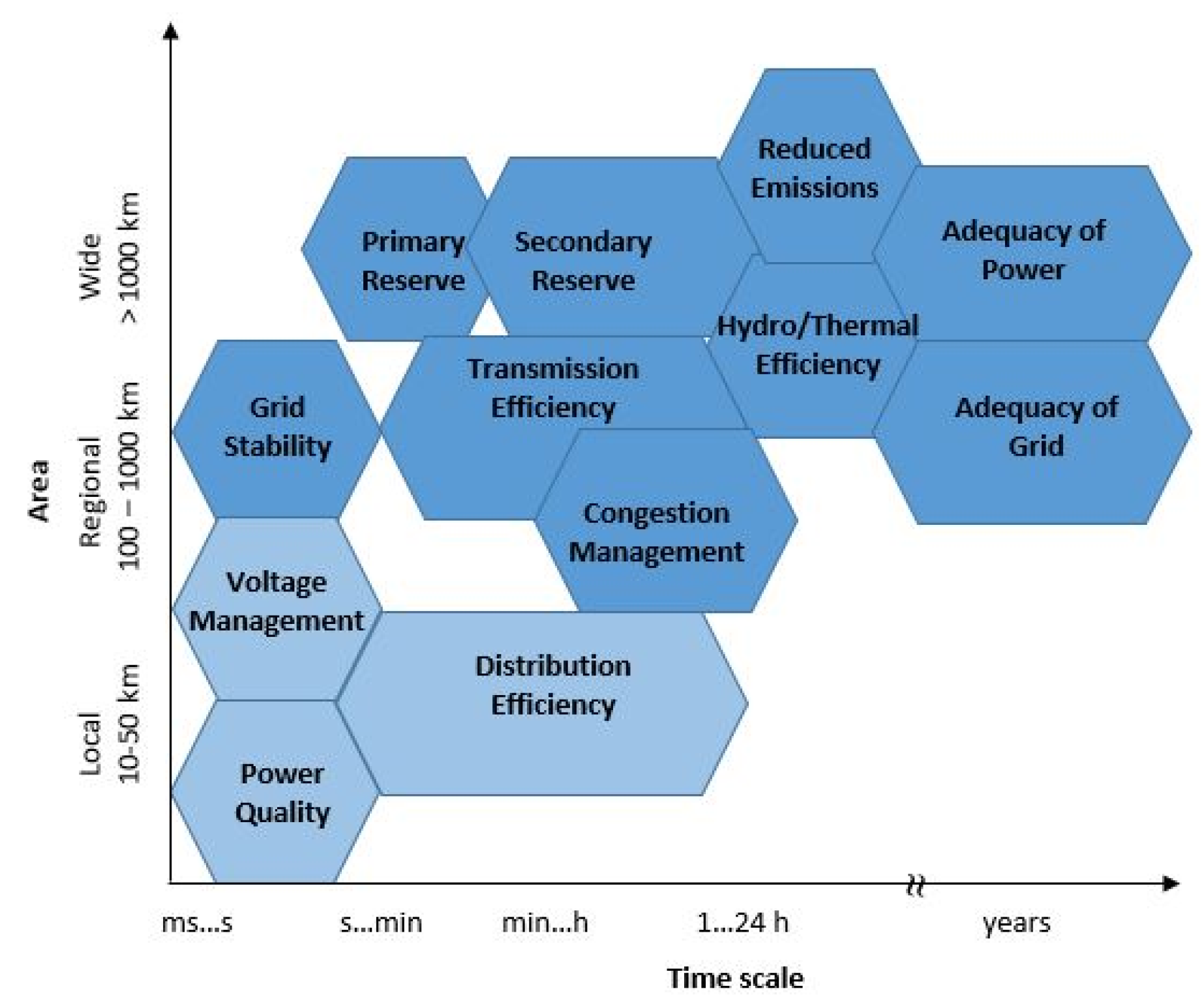
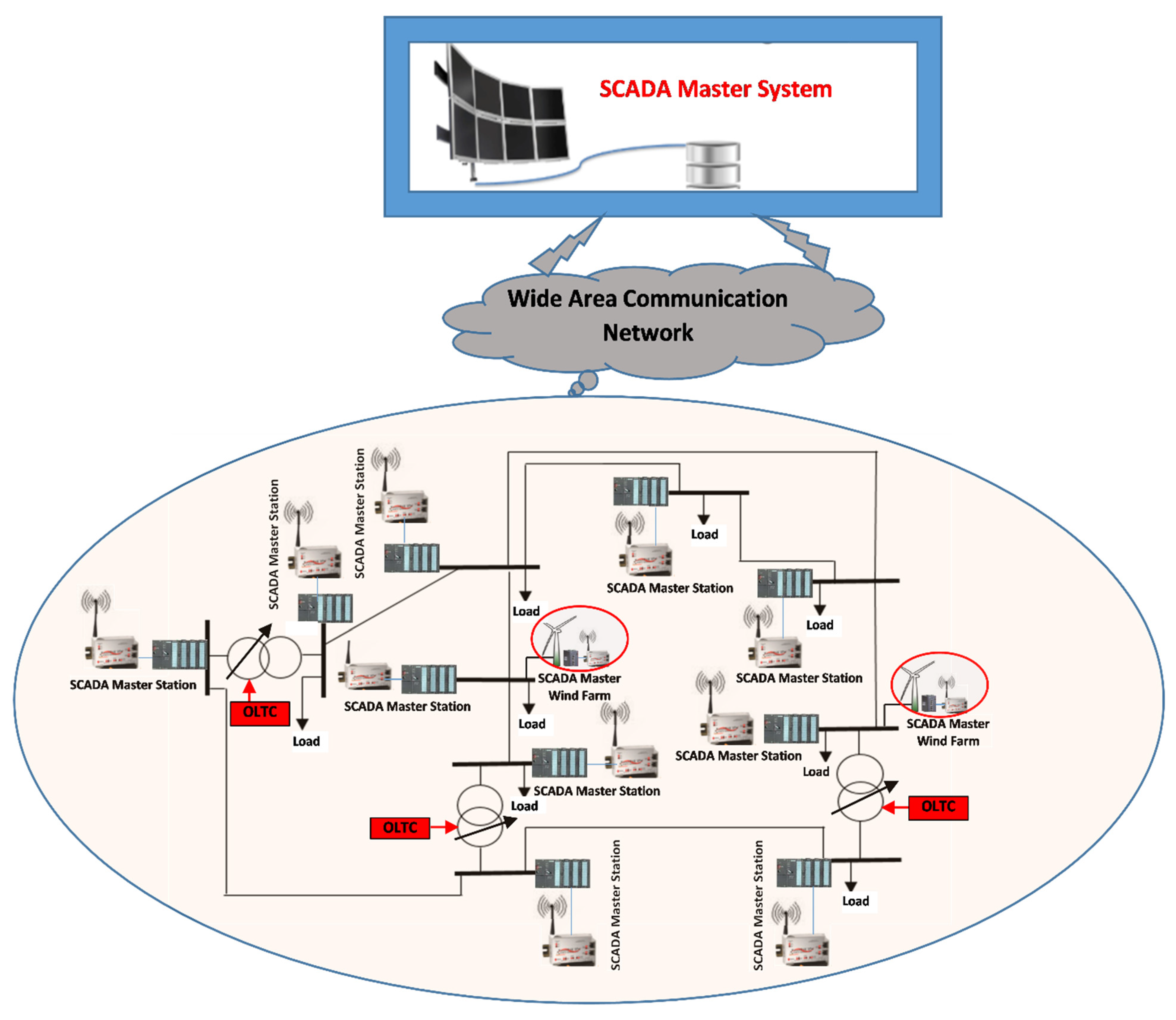
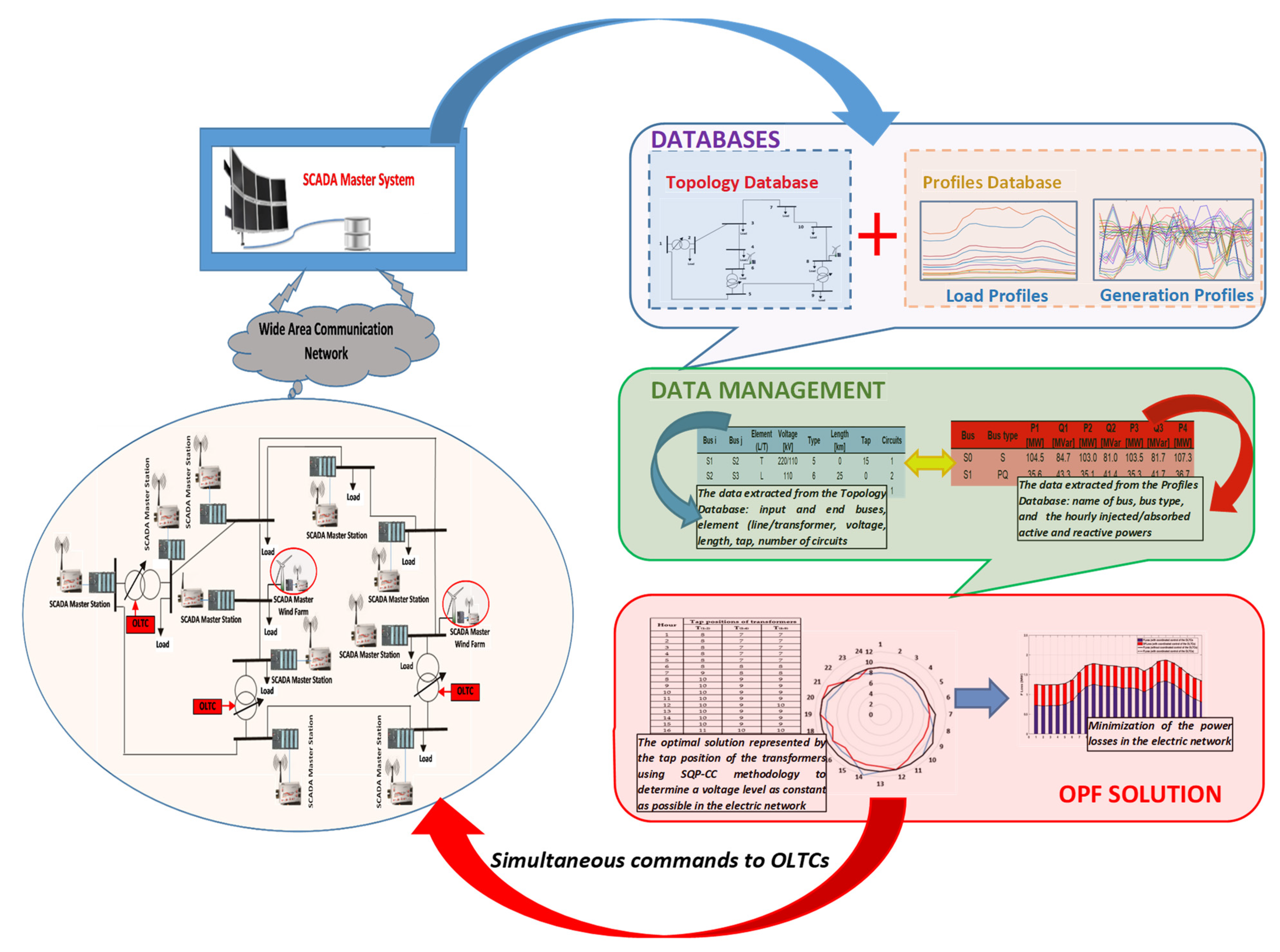

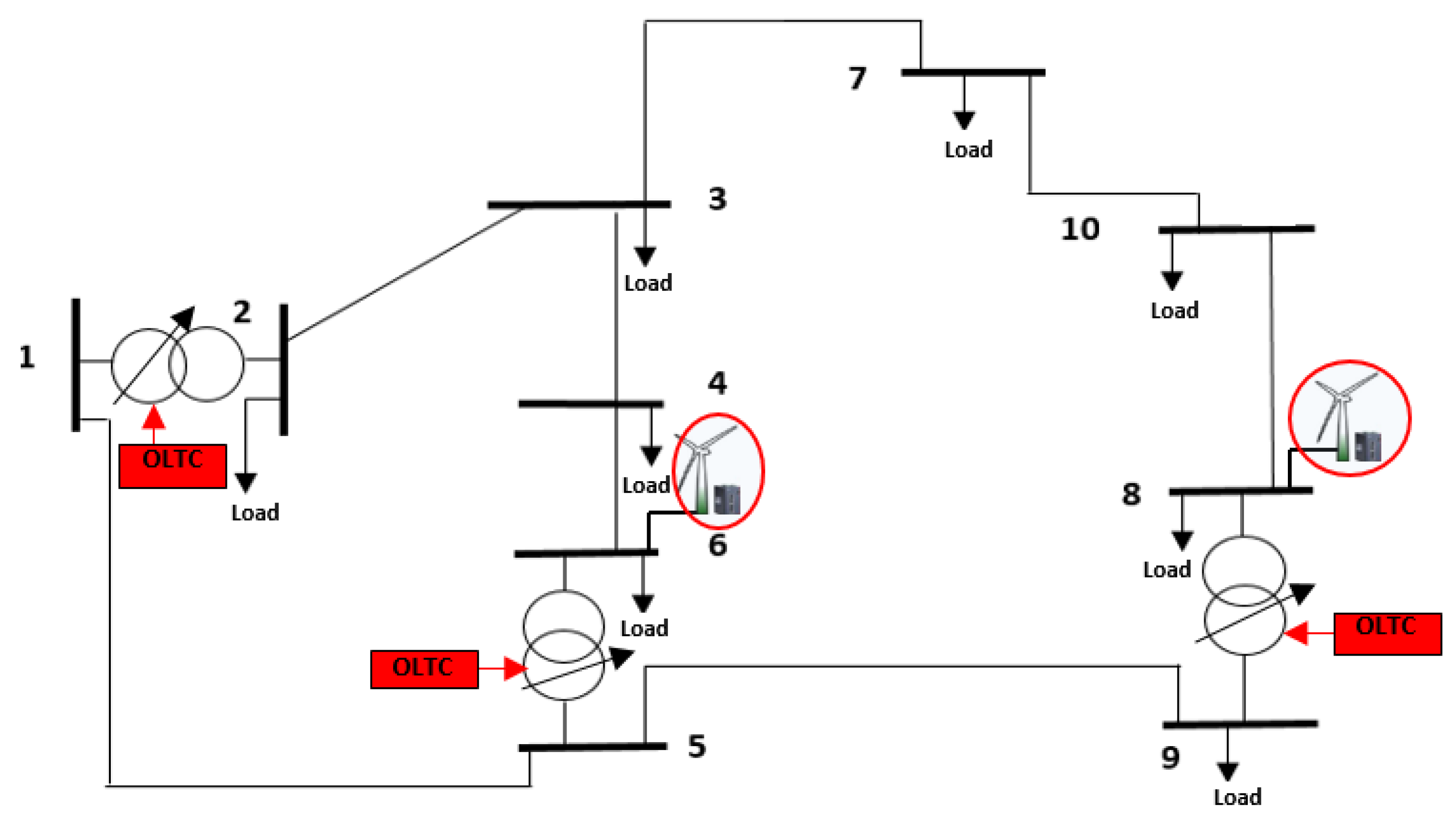
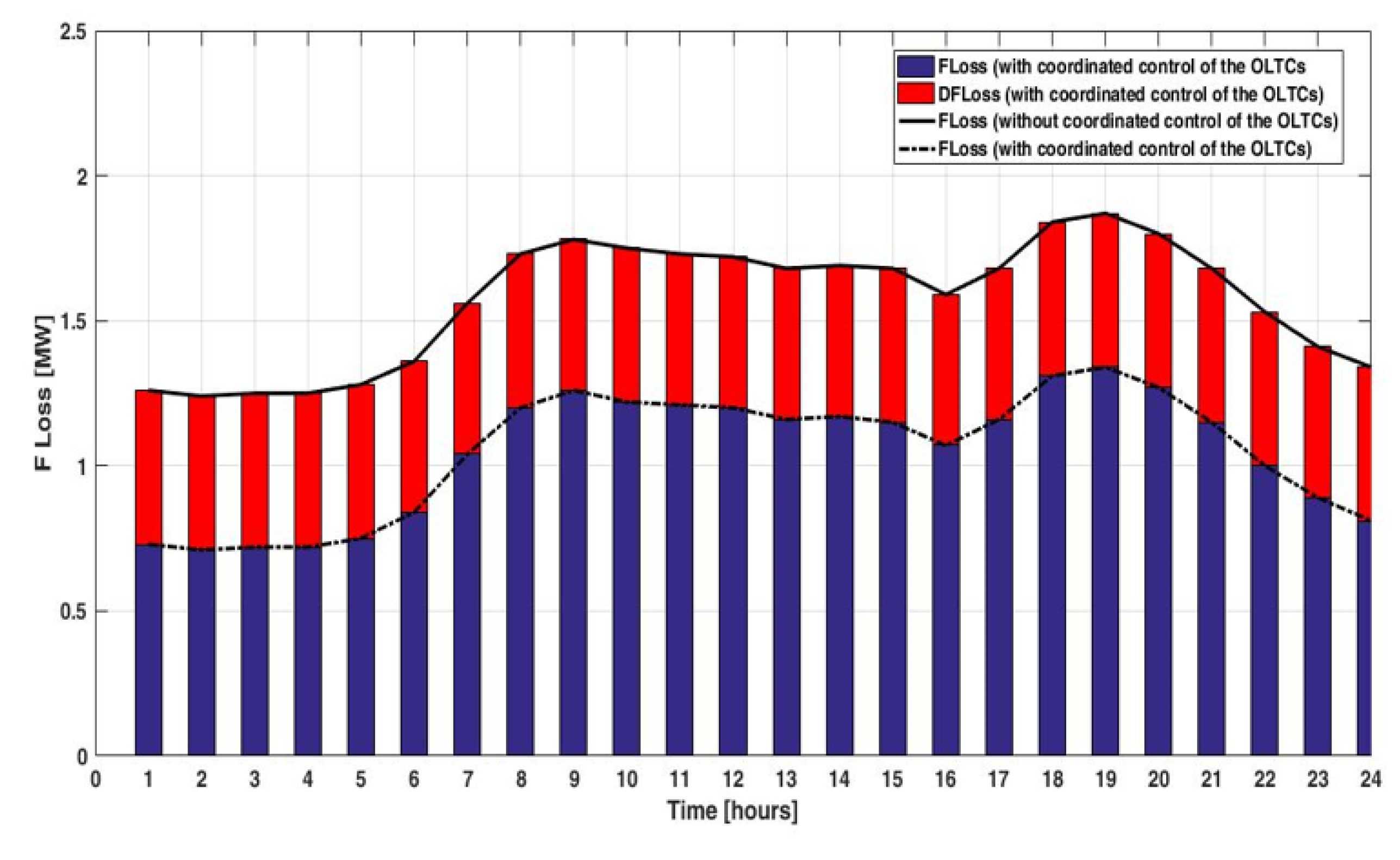
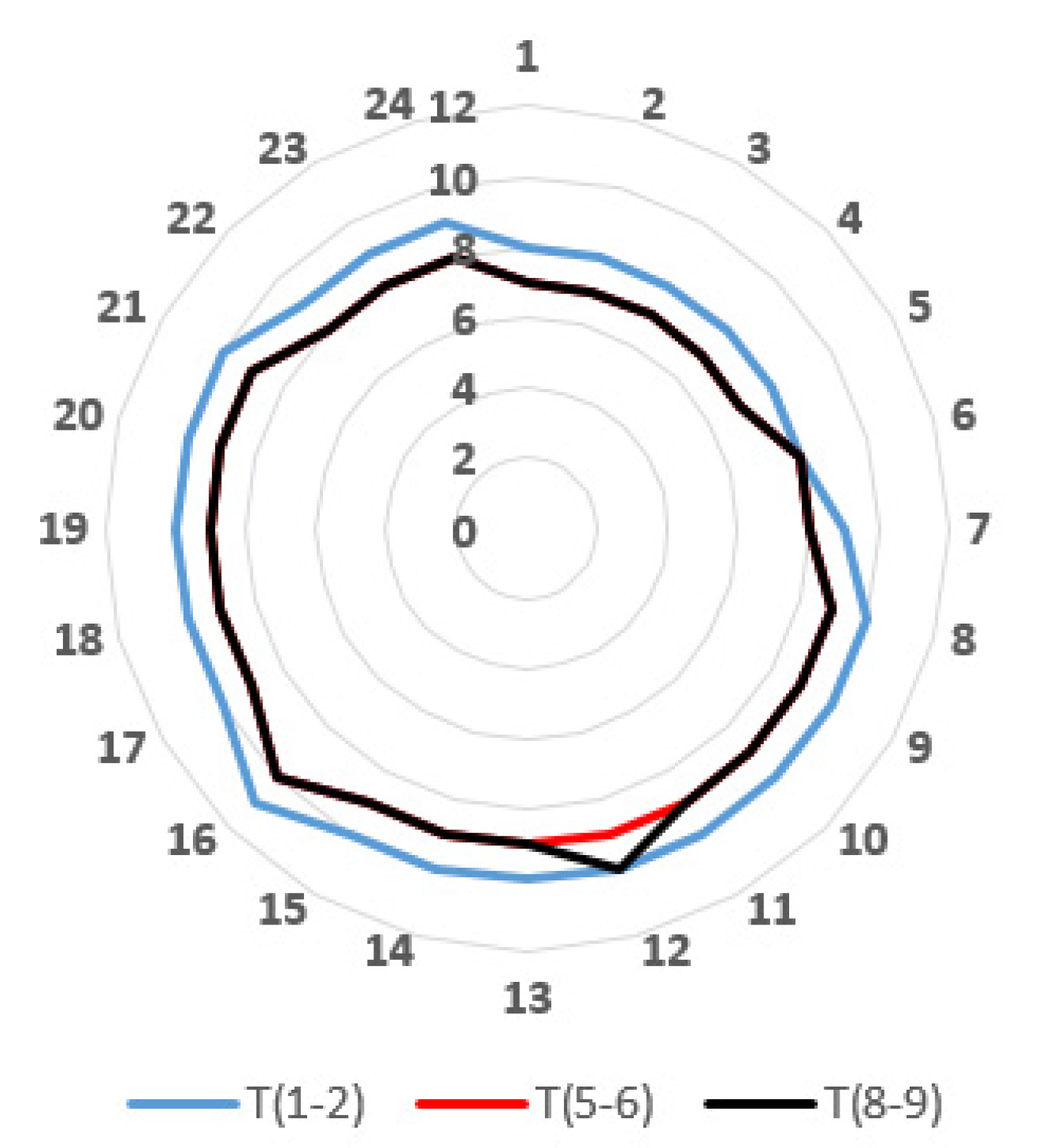


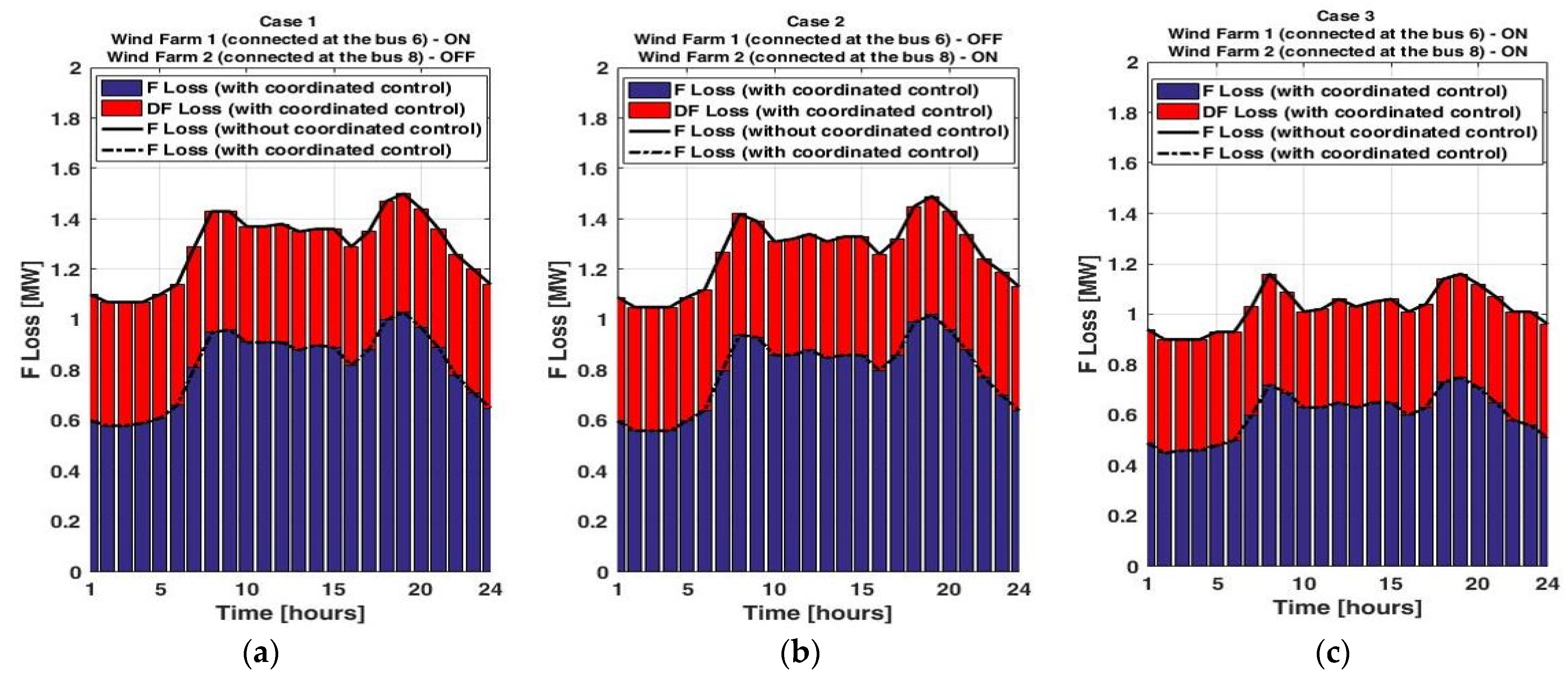
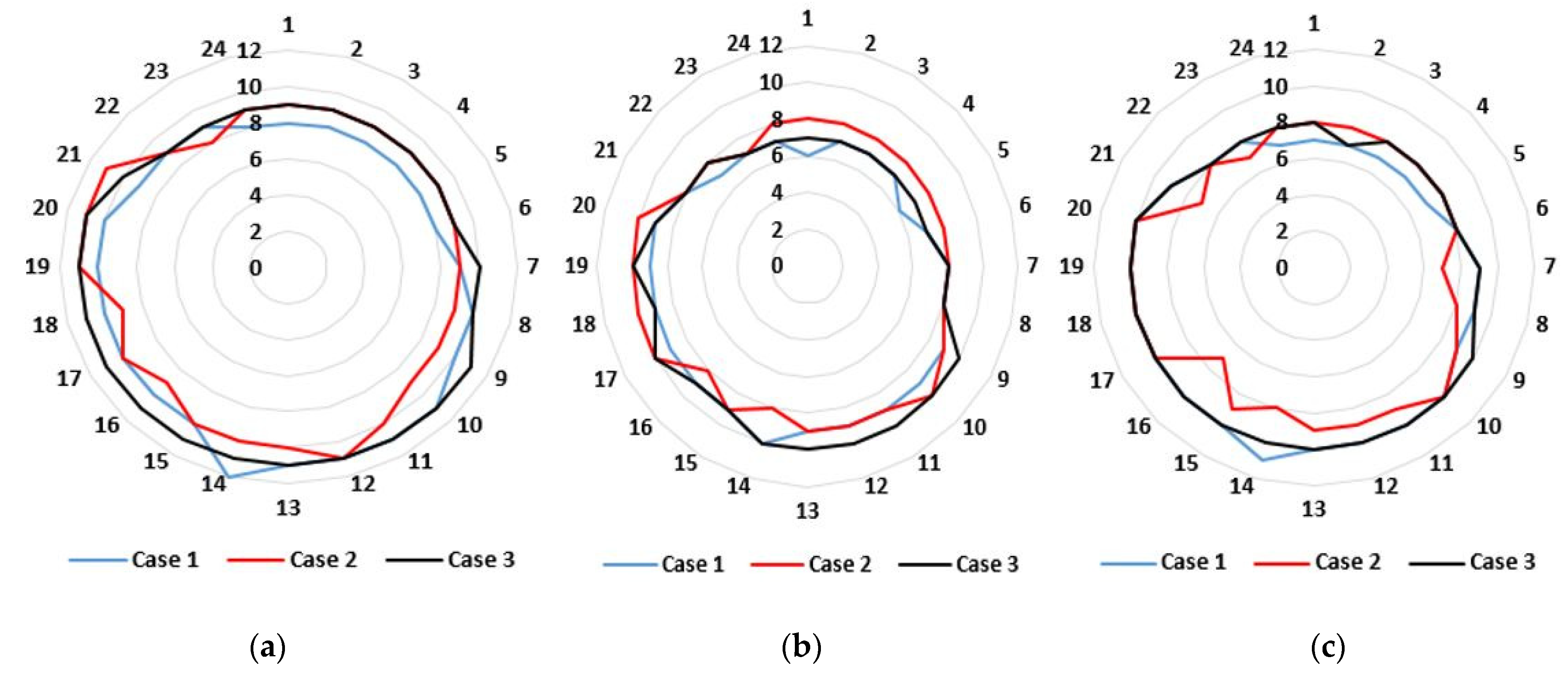

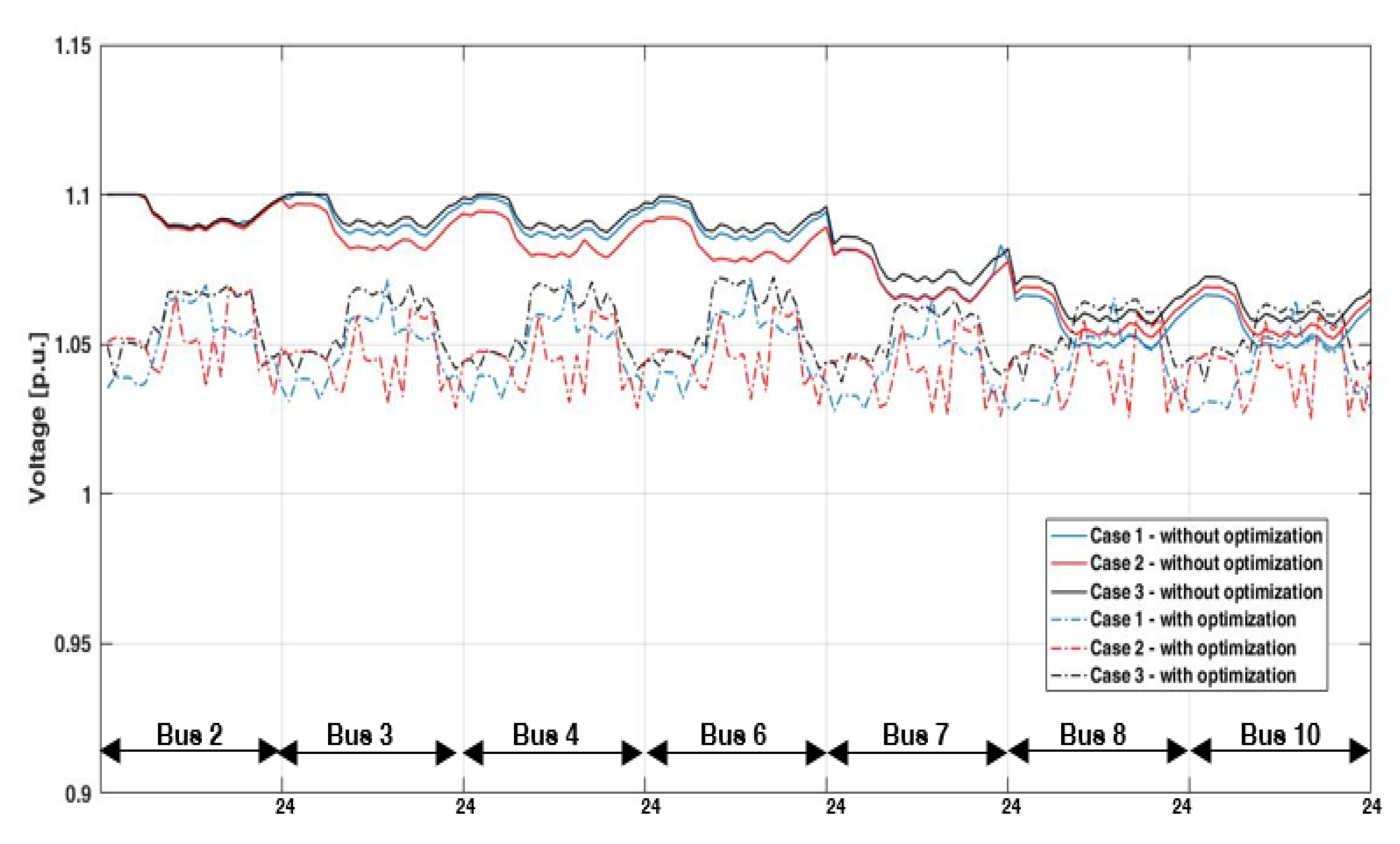
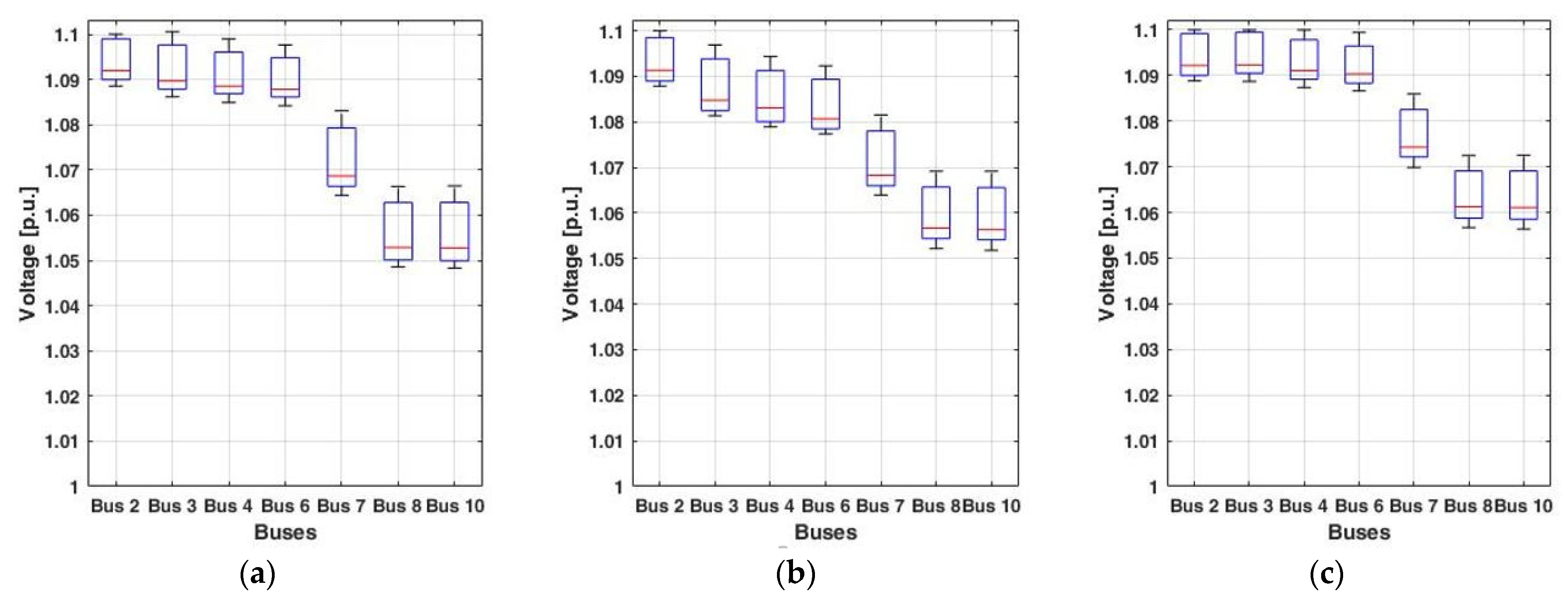

| Reference | Year | The Treated Topic | Contribution | Optimization Method |
|---|---|---|---|---|
| [20] | 2021 | Impact of the grid regulation | Investigation of the optimal utilization of grid capacity in the presence of high wind energy penetration in a hydropower dominated system | Linear programming—classic optimization |
| [21] | 2020 | Contingency Constrained Optimal Power Flow | Optimal power flow model that forces the network to meet all constraints under contingency | Quadratic Programming—classic optimization |
| [22] | 2019 | Optimal power flow problems for hybrid power systems containing renewable energy sources (wind and solar power) | Developing and solving different constrained optimal power flow problems using a hybrid approach | Sequential quadratic programming improved with an imperialist competitive algorithm—hybrid optimization |
| [23] | 2017 | Optimal power flow problem | A new solution to the alternating current optimal power flow problem based on successive linear approximation of power flow equations | Successive linear approximation—classic optimization |
| [24] | 2017 | Optimal operation of power system incorporating wind energy with demand-side management | Dynamic economic dispatch considering discrete penetration levels of wind energy and utilizing the demand-side management | Genetic algorithm—meta-heuristic optimization |
| [25] | 2021 | Optimal power flow based on the wind sources integrated into the power system | A stochastic optimal power flow to obtain the best solution for the scheduled power from wind farms with the low operational costs | Aquila optimizer—meta-heuristic optimization |
| [26] | 2018 | Multi-objective optimal dispatch considering wind power and interactive load | The characteristics of interactive load are analyzed based on the traditional day-ahead dispatch model to reduce the influence of wind power variability | Quantum particle swarm optimization—meta-heuristic optimization |
| [27] | 2016 | Optimal operation of a power system including the solar and wind energy sources. | The optimal operation of a hybrid power system including the solar and wind energy sources based on an improved PSO algorithm | Particle swarm optimization—meta-heuristic optimization |
| [28] | 2017 | Impact on renewable energy sources integrated into the Romanian power system on the electrical network operation considering the reduction of electricity consumption | The guidelines for a decision-making process leading to rapid implementation of renewable sources in the context of Romania’s energy network | Only steady-state calculus in various scenarios |
| [29] | 2015 | Optimal power flow in the presence of wind power | The optimal power flow with the wind power sources integrated | Cuckoo search—meta-heuristic optimization |
| [30] | 2018 | Impact of incorporating wind power generation on the power system on presence of voltage source converter | The optimal power flow incorporating wind power generation on the presence of VSC-HVDC | Ant Lion optimizer—meta-heuristic optimization |
| [31] | 2021 | Optimal operation of the power systems, including the solar sources | The optimal power flow, including minimization of the fuel cost and improving the dynamic performance | Gradient descent algorithm—classic optimization |
| [32] | 2016 | Optimal operation of the large electric networks with distributed energy resources | The optimal power flow from the radial electric networks integrating distributed energy resources | Gradient algorithm—classic optimization |
| [33] | 2008 | Optimal operation of the power systems | A new strategy based on reduced gradient method with techniques from augmented Lagrangian and log-barrier to solve the optimal power flow | Reduced gradient method combined with the augmented Lagrangian method with barriers—classic optimization |
| Voltage Level | Vector | Elements | ||||||||
|---|---|---|---|---|---|---|---|---|---|---|
| 110 kV | VA | Area 1 | Area 2 | Area 3 | Area 4 | |||||
| VE | T1 | L1 | L3 | L4 | T2 | L2 | L5 | L6 | T3 | |
| 220 kV | VA | Area 1 | Area 2 | |||||||
| VE | L1 | L2 | ||||||||
| Bus i | Bus j | Element (L/T) | Voltage [kV] | Type | Length [km] | Tap | Circuits |
|---|---|---|---|---|---|---|---|
| SB | Bus 1 | T | 220/110 | 5 | 0 | 15 | 1 |
| Bus 1 | Bus 2 | L | 110 | 6 | 25 | 0 | 2 |
| Bus 2 | Bus 3 | L | 110 | 10 | 18 | 0 | 1 |
| Bus | Bus Type | P1 [MW] | Q1 [MVAr] | P2 [MW] | Q2 [MVAr] | P3 [MW] | Q3 [MVAr] | P4 [MW] |
|---|---|---|---|---|---|---|---|---|
| SB | S | 104.5 | 84.7 | 103.0 | 81.0 | 103.5 | 81.7 | 107.3 |
| Bus 1 | PQ | 35.6 | 43.3 | 35.1 | 41.4 | 35.3 | 41.7 | 36.7 |
| Bus 2 | PQ | 7.1 | 1.5 | 7.0 | 1.4 | 7.4 | 1.6 | 8.4 |
| Hour | ΔFLoss (MW) | ΔFLoss [%] | Tap Positions of Transformers ** | ||||
|---|---|---|---|---|---|---|---|
| T(1,2) (Tap * = 15) | T(5,6) (Tap * = 10) | T(8,9) (Tap * = 8) | |||||
| 1 | 1.260 | 0.730 | 0.530 | 42.06 | 8 | 7 | 7 |
| 2 | 1.240 | 0.710 | 0.530 | 42.74 | 8 | 7 | 7 |
| 3 | 1.250 | 0.720 | 0.530 | 42.40 | 8 | 7 | 7 |
| 4 | 1.250 | 0.720 | 0.530 | 42.40 | 8 | 7 | 7 |
| 5 | 1.280 | 0.750 | 0.530 | 41.41 | 8 | 7 | 7 |
| 6 | 1.360 | 0.840 | 0.520 | 38.24 | 8 | 8 | 8 |
| 7 | 1.560 | 1.040 | 0.520 | 33.33 | 9 | 8 | 8 |
| 8 | 1.730 | 1.200 | 0.530 | 30.64 | 10 | 9 | 9 |
| 9 | 1.780 | 1.260 | 0.520 | 29.21 | 10 | 9 | 9 |
| 10 | 1.750 | 1.220 | 0.530 | 30.29 | 10 | 9 | 9 |
| 11 | 1.730 | 1.210 | 0.520 | 30.06 | 10 | 9 | 9 |
| 12 | 1.720 | 1.200 | 0.520 | 30.23 | 10 | 9 | 10 |
| 13 | 1.680 | 1.160 | 0.520 | 30.95 | 10 | 9 | 9 |
| 14 | 1.690 | 1.170 | 0.520 | 30.77 | 10 | 9 | 9 |
| 15 | 1.680 | 1.150 | 0.530 | 31.55 | 10 | 9 | 9 |
| 16 | 1.590 | 1.070 | 0.520 | 32.70 | 11 | 10 | 10 |
| 17 | 1.680 | 1.160 | 0.520 | 30.95 | 10 | 9 | 9 |
| 18 | 1.840 | 1.310 | 0.530 | 28.80 | 10 | 9 | 9 |
| 19 | 1.870 | 1.340 | 0.530 | 28.34 | 10 | 9 | 9 |
| 20 | 1.800 | 1.270 | 0.530 | 29.44 | 10 | 9 | 9 |
| 21 | 1.680 | 1.150 | 0.530 | 31.55 | 10 | 9 | 9 |
| 22 | 1.530 | 1.000 | 0.530 | 34.64 | 9 | 8 | 8 |
| 23 | 1.410 | 0.890 | 0.520 | 36.88 | 9 | 8 | 8 |
| 24 | 1.340 | 0.810 | 0.530 | 39.55 | 9 | 8 | 8 |
| Statistical Parameters | without Coordinated Control of the OLTCs | with Coordinated Control of the OLTCs | |||||||||||||
|---|---|---|---|---|---|---|---|---|---|---|---|---|---|---|---|
| Bus2 | Bus3 | Bus4 | Bus6 | Bus7 | Bus8 | Bus10 | Bus2 | Bus3 | Bus4 | Bus6 | Bus7 | Bus8 | Bus10 | ||
| Quartiles | Q0 | 1.088 | 1.078 | 1.076 | 1.075 | 1.058 | 1.044 | 1.044 | 1.036 | 1.031 | 1.031 | 1.032 | 1.027 | 1.027 | 1.023 |
| Q1 | 1.089 | 1.080 | 1.077 | 1.076 | 1.059 | 1.045 | 1.045 | 1.038 | 1.034 | 1.035 | 1.036 | 1.030 | 1.030 | 1.029 | |
| Q2 | 1.091 | 1.082 | 1.080 | 1.078 | 1.063 | 1.048 | 1.048 | 1.051 | 1.042 | 1.042 | 1.043 | 1.035 | 1.034 | 1.034 | |
| Q3 | 1.098 | 1.092 | 1.089 | 1.087 | 1.074 | 1.059 | 1.059 | 1.053 | 1.044 | 1.044 | 1.045 | 1.037 | 1.037 | 1.036 | |
| Q4 | 1.100 | 1.095 | 1.092 | 1.090 | 1.077 | 1.063 | 1.063 | 1.056 | 1.050 | 1.052 | 1.051 | 1.045 | 1.043 | 1.043 | |
| Hour | Tap Positions of Transformers ** | ||||||||||||||
|---|---|---|---|---|---|---|---|---|---|---|---|---|---|---|---|
| T(1,2) (Tap * = 15) | T(5,6) (Tap * = 10) | T(8,9) (Tap * = 8) | |||||||||||||
| C1 | C2 | C3 | C1 | C2 | C3 | C1 | C2 | C3 | C1 | C2 | C3 | C1 | C2 | C3 | |
| 1 | 1.10 | 1.09 | 0.94 | 0.60 | 0.60 | 0.49 | 8 | 9 | 9 | 6 | 8 | 7 | 7 | 8 | 8 |
| 2 | 1.07 | 1.05 | 0.90 | 0.58 | 0.56 | 0.45 | 8 | 9 | 9 | 7 | 8 | 7 | 7 | 8 | 7 |
| 3 | 1.07 | 1.05 | 0.90 | 0.58 | 0.56 | 0.46 | 8 | 9 | 9 | 7 | 8 | 7 | 7 | 8 | 8 |
| 4 | 1.07 | 1.05 | 0.90 | 0.59 | 0.56 | 0.46 | 8 | 9 | 9 | 7 | 8 | 7 | 7 | 8 | 8 |
| 5 | 1.10 | 1.09 | 0.93 | 0.61 | 0.60 | 0.48 | 8 | 9 | 9 | 6 | 8 | 7 | 7 | 8 | 8 |
| 6 | 1.14 | 1.12 | 0.93 | 0.66 | 0.64 | 0.50 | 8 | 9 | 9 | 7 | 8 | 7 | 8 | 8 | 8 |
| 7 | 1.29 | 1.27 | 1.03 | 0.81 | 0.80 | 0.60 | 9 | 9 | 10 | 8 | 8 | 8 | 9 | 7 | 9 |
| 8 | 1.43 | 1.42 | 1.16 | 0.95 | 0.94 | 0.72 | 10 | 9 | 10 | 8 | 8 | 8 | 9 | 8 | 9 |
| 9 | 1.43 | 1.39 | 1.09 | 0.96 | 0.93 | 0.69 | 10 | 9 | 11 | 9 | 9 | 10 | 9 | 9 | 10 |
| 10 | 1.37 | 1.31 | 1.01 | 0.91 | 0.86 | 0.63 | 11 | 9 | 11 | 9 | 10 | 10 | 10 | 10 | 10 |
| 11 | 1.37 | 1.32 | 1.02 | 0.91 | 0.86 | 0.63 | 11 | 10 | 11 | 9 | 9 | 10 | 10 | 9 | 10 |
| 12 | 1.38 | 1.34 | 1.06 | 0.91 | 0.88 | 0.65 | 11 | 11 | 11 | 9 | 9 | 10 | 10 | 9 | 10 |
| 13 | 1.35 | 1.31 | 1.03 | 0.88 | 0.85 | 0.63 | 11 | 10 | 11 | 9 | 9 | 10 | 10 | 9 | 10 |
| 14 | 1.36 | 1.33 | 1.05 | 0.90 | 0.86 | 0.65 | 12 | 10 | 11 | 10 | 8 | 10 | 11 | 8 | 10 |
| 15 | 1.36 | 1.33 | 1.06 | 0.89 | 0.86 | 0.65 | 10 | 10 | 11 | 9 | 9 | 9 | 10 | 9 | 10 |
| 16 | 1.29 | 1.26 | 1.01 | 0.82 | 0.80 | 0.60 | 10 | 9 | 11 | 9 | 8 | 9 | 10 | 7 | 10 |
| 17 | 1.35 | 1.32 | 1.04 | 0.88 | 0.86 | 0.63 | 10 | 10 | 11 | 9 | 10 | 10 | 10 | 10 | 10 |
| 18 | 1.47 | 1.45 | 1.14 | 1.00 | 0.99 | 0.73 | 10 | 9 | 11 | 9 | 10 | 9 | 10 | 10 | 10 |
| 19 | 1.50 | 1.49 | 1.16 | 1.03 | 1.02 | 0.75 | 10 | 11 | 11 | 9 | 10 | 10 | 10 | 10 | 10 |
| 20 | 1.44 | 1.43 | 1.12 | 0.97 | 0.96 | 0.71 | 10 | 11 | 11 | 9 | 10 | 9 | 10 | 10 | 10 |
| 21 | 1.36 | 1.34 | 1.07 | 0.89 | 0.88 | 0.65 | 9 | 11 | 10 | 8 | 8 | 8 | 9 | 7 | 9 |
| 22 | 1.26 | 1.24 | 1.01 | 0.78 | 0.77 | 0.58 | 9 | 9 | 9 | 7 | 8 | 8 | 8 | 8 | 8 |
| 23 | 1.20 | 1.19 | 1.01 | 0.71 | 0.70 | 0.56 | 9 | 8 | 9 | 7 | 7 | 7 | 8 | 7 | 8 |
| 24 | 1.14 | 1.13 | 0.96 | 0.65 | 0.64 | 0.51 | 8 | 9 | 9 | 7 | 8 | 7 | 7 | 8 | 8 |
| Statistical Parameters | without Coordinated Control of the OLTCs | with Coordinated Control of the OLTCs | |||||||||||||
|---|---|---|---|---|---|---|---|---|---|---|---|---|---|---|---|
| Bus2 | Bus3 | Bus4 | Bus6 | Bus7 | Bus8 | Bus10 | Bus2 | Bus3 | Bus4 | Bus6 | Bus7 | Bus8 | Bus10 | ||
| Quartiles | Q0 | 1.089 | 1.086 | 1.085 | 1.084 | 1.064 | 1.049 | 1.048 | 1.035 | 1.031 | 1.031 | 1.031 | 1.028 | 1.027 | 1.027 |
| Q1 | 1.090 | 1.088 | 1.087 | 1.086 | 1.066 | 1.050 | 1.050 | 1.039 | 1.038 | 1.039 | 1.040 | 1.033 | 1.033 | 1.032 | |
| Q2 | 1.092 | 1.090 | 1.089 | 1.088 | 1.069 | 1.053 | 1.053 | 1.053 | 1.049 | 1.049 | 1.050 | 1.044 | 1.045 | 1.044 | |
| Q3 | 1.099 | 1.098 | 1.096 | 1.095 | 1.079 | 1.063 | 1.063 | 1.060 | 1.056 | 1.057 | 1.058 | 1.051 | 1.052 | 1.051 | |
| Q4 | 1.100 | 1.100 | 1.099 | 1.098 | 1.083 | 1.066 | 1.066 | 1.070 | 1.072 | 1.072 | 1.072 | 1.066 | 1.066 | 1.065 | |
| Statistical Parameters | without Coordinated Control of the OLTCs | with Coordinated Control of the OLTCs | |||||||||||||
|---|---|---|---|---|---|---|---|---|---|---|---|---|---|---|---|
| Bus2 | Bus3 | Bus4 | Bus6 | Bus7 | Bus8 | Bus10 | Bus2 | Bus3 | Bus4 | Bus6 | Bus7 | Bus8 | Bus10 | ||
| Quartiles | Q0 | 1.088 | 1.081 | 1.079 | 1.077 | 1.064 | 1.052 | 1.052 | 1.033 | 1.029 | 1.029 | 1.029 | 1.026 | 1.026 | 1.025 |
| Q1 | 1.089 | 1.083 | 1.080 | 1.078 | 1.066 | 1.054 | 1.054 | 1.043 | 1.037 | 1.038 | 1.038 | 1.033 | 1.035 | 1.035 | |
| Q2 | 1.091 | 1.085 | 1.083 | 1.081 | 1.068 | 1.057 | 1.056 | 1.051 | 1.045 | 1.045 | 1.046 | 1.042 | 1.045 | 1.044 | |
| Q3 | 1.099 | 1.094 | 1.091 | 1.089 | 1.078 | 1.066 | 1.066 | 1.052 | 1.048 | 1.047 | 1.048 | 1.046 | 1.047 | 1.047 | |
| Q4 | 1.100 | 1.097 | 1.094 | 1.092 | 1.082 | 1.069 | 1.069 | 1.069 | 1.062 | 1.062 | 1.062 | 1.058 | 1.060 | 1.059 | |
| Statistical Parameters | without Coordinated Control of the OLTCs | with Coordinated Control of the OLTCs | |||||||||||||
|---|---|---|---|---|---|---|---|---|---|---|---|---|---|---|---|
| Bus2 | Bus3 | Bus4 | Bus6 | Bus7 | Bus8 | Bus10 | Bus2 | Bus3 | Bus4 | Bus6 | Bus7 | Bus8 | Bus10 | ||
| Quartiles | Q0 | 1.089 | 1.089 | 1.087 | 1.087 | 1.070 | 1.057 | 1.056 | 1.039 | 1.040 | 1.041 | 1.042 | 1.037 | 1.038 | 1.037 |
| Q1 | 1.090 | 1.091 | 1.089 | 1.088 | 1.072 | 1.059 | 1.059 | 1.050 | 1.047 | 1.047 | 1.047 | 1.045 | 1.047 | 1.047 | |
| Q2 | 1.092 | 1.092 | 1.091 | 1.090 | 1.074 | 1.061 | 1.061 | 1.061 | 1.056 | 1.056 | 1.057 | 1.054 | 1.056 | 1.056 | |
| Q3 | 1.099 | 1.099 | 1.098 | 1.096 | 1.083 | 1.069 | 1.069 | 1.067 | 1.066 | 1.068 | 1.069 | 1.061 | 1.062 | 1.061 | |
| Q4 | 1.100 | 1.100 | 1.100 | 1.099 | 1.086 | 1.073 | 1.073 | 1.070 | 1.070 | 1.071 | 1.073 | 1.065 | 1.065 | 1.064 | |
| Algorithm | CTav (Seconds) | FLoss (MWh) | ||
|---|---|---|---|---|
| Case 1 | Case 2 | Case 3 | ||
| SQP-CC (Proposed) | 0.24 | 19.51 | 18.96 | 14.40 |
| RG-CC | 0.35 | 19.77 | 19.56 | 14.79 |
Publisher’s Note: MDPI stays neutral with regard to jurisdictional claims in published maps and institutional affiliations. |
© 2022 by the authors. Licensee MDPI, Basel, Switzerland. This article is an open access article distributed under the terms and conditions of the Creative Commons Attribution (CC BY) license (https://creativecommons.org/licenses/by/4.0/).
Share and Cite
Grigoraș, G.; Neagu, B.-C.; Ivanov, O.; Livadariu, B.; Scarlatache, F. A New SQP Methodology for Coordinated Transformer Tap Control Optimization in Electric Networks Integrating Wind Farms. Appl. Sci. 2022, 12, 1129. https://doi.org/10.3390/app12031129
Grigoraș G, Neagu B-C, Ivanov O, Livadariu B, Scarlatache F. A New SQP Methodology for Coordinated Transformer Tap Control Optimization in Electric Networks Integrating Wind Farms. Applied Sciences. 2022; 12(3):1129. https://doi.org/10.3390/app12031129
Chicago/Turabian StyleGrigoraș, Gheorghe, Bogdan-Constantin Neagu, Ovidiu Ivanov, Bogdan Livadariu, and Florina Scarlatache. 2022. "A New SQP Methodology for Coordinated Transformer Tap Control Optimization in Electric Networks Integrating Wind Farms" Applied Sciences 12, no. 3: 1129. https://doi.org/10.3390/app12031129
APA StyleGrigoraș, G., Neagu, B.-C., Ivanov, O., Livadariu, B., & Scarlatache, F. (2022). A New SQP Methodology for Coordinated Transformer Tap Control Optimization in Electric Networks Integrating Wind Farms. Applied Sciences, 12(3), 1129. https://doi.org/10.3390/app12031129










